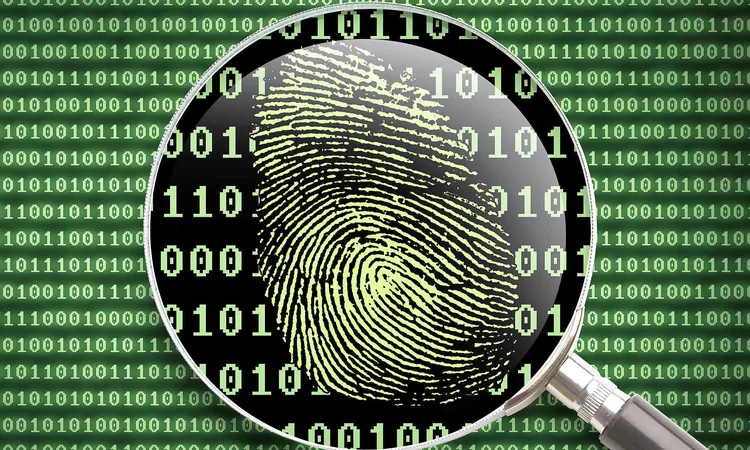
Breaking: AI Challenges Century-Old Forensic Beliefs About Fingerprints!
2025-04-07
Author: Ying
Groundbreaking Revelation
In a groundbreaking revelation that could shake the foundations of the legal system, researchers have discovered that fingerprints may not be as unique as previously believed. For over a hundred years, law enforcement agencies have relied on fingerprint analysis, viewing it as an infallible method of identifying suspects and linking them to crime scenes. But a new study utilizing artificial intelligence (AI) has thrown a wrench into this long-held belief.
The Research Team and Methodology
The research team, led by Hod Lipson of Columbia Engineering and Wenyao Xu from the University at Buffalo, unearthed alarming insights that indicate fingerprints from different fingers of the same individual can sometimes appear strikingly similar. With the aid of an innovative AI model, the researchers analyzed a public U.S. government database containing around 60,000 fingerprints. Under the guidance of undergraduate researcher Gabe Guo, they employed a deep contrastive network to compare these prints, both from the same individuals and from different people.
AI Accuracy and Implications
The AI system achieved an impressive accuracy of 77% in distinguishing prints that appeared dissimilar but actually derived from the same person. When multiple samples were assessed together, the accuracy skyrocketed, suggesting that this method could enhance existing forensic practices by over tenfold. This has far-reaching implications for the criminal justice system, including the potential for reopening cold cases and exonerating the innocent.
Resistance from Forensic Community
However, despite the promising findings, the researchers faced significant resistance from the established forensic community. Their initial paper was rejected by a prominent forensics journal, which staunchly upheld the dogma that each fingerprint is inherently unique. Undeterred, Lipson and his team continued to refine their work and eventually succeeded in having their research published in the peer-reviewed journal *Science Advances*.
Innovative AI Methodology
One of the most notable distinctions of this research is the method used by the AI. Traditional fingerprint analysis relies on minutiae—features like ridge endings and bifurcations—while the AI focused on different aspects such as angles and curvatures of the fingerprint's central swirls and loops. This departure from conventional techniques has opened the door to potentially overlooked visual cues that could enhance forensic examinations.
Need for Larger Datasets
Moreover, the authors acknowledged the need for diverse and larger datasets to validate their findings, expressing a commitment to overcoming potential biases that may arise from the data used. This initiative aims to equip law enforcement officials with a powerful analytical tool for untangling complex cases and narrowing down suspect lists based on partial fingerprint matches.
Vision for the Future
Lipson emphasized the importance of utilizing underexplored datasets, stating, “This research illustrates how even a straightforward AI can extract insights from data that has been sitting idle for years.” The notion that an undergraduate with no formal background in forensic science could challenge a deeply entrenched belief presents a vision of the future where non-experts may catalyze a new wave of discoveries powered by AI.
Implications for Forensic Science and the Legal System
As the implications of this research unfold, forensic experts may find themselves rethinking standard practices, especially when encountering multiple fingerprints from the same suspect across various crime scenes. The findings serve as a critical reminder that the field of forensic science must be adaptable and open to innovation—especially in a world where technology is rapidly advancing.
A Transformative Shift Ahead?
This revolutionary approach not only raises questions about the traditional reliance on fingerprint uniqueness but also paves the way for future explorations in the intersection of AI and forensic science. The legal system could witness a transformative shift if these methods gain acceptance and find their way into practical applications. With the rise of AI, we may be on the brink of an explosion of scientific discovery, leading to a future where the unexpected becomes standard practice in law enforcement.
Stay Tuned!
Stay tuned for more updates as we continue to track this evolving story at the intersection of technology and justice!



 Brasil (PT)
Brasil (PT)
 Canada (EN)
Canada (EN)
 Chile (ES)
Chile (ES)
 Česko (CS)
Česko (CS)
 대한민국 (KO)
대한민국 (KO)
 España (ES)
España (ES)
 France (FR)
France (FR)
 Hong Kong (EN)
Hong Kong (EN)
 Italia (IT)
Italia (IT)
 日本 (JA)
日本 (JA)
 Magyarország (HU)
Magyarország (HU)
 Norge (NO)
Norge (NO)
 Polska (PL)
Polska (PL)
 Schweiz (DE)
Schweiz (DE)
 Singapore (EN)
Singapore (EN)
 Sverige (SV)
Sverige (SV)
 Suomi (FI)
Suomi (FI)
 Türkiye (TR)
Türkiye (TR)
 الإمارات العربية المتحدة (AR)
الإمارات العربية المتحدة (AR)